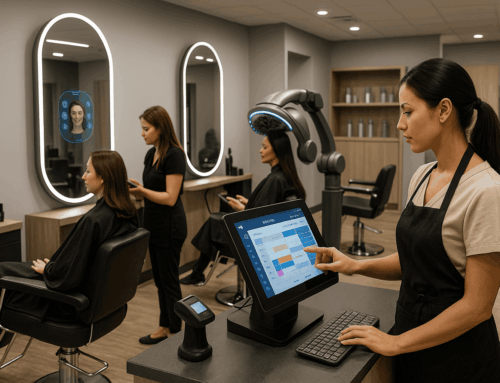Running a bookstore in today’s retail environment isn’t easy. Whether you sell bestsellers, rare finds, children’s books, or a mix of everything, the challenges facing bookstores have become increasingly complex. If your bookstore business is failing or experiencing a noticeable downward trend in revenue, foot traffic, or morale, this ultimate guide is designed to help you identify the problem, fix it, and turn your store around.
In this article, we’ll explore how to:
- Diagnose why your bookstore is struggling
- Fix internal issues like employee accountability and checkout errors
- Address external issues like competition and changing foot traffic
- Use POS software to your advantage
- Implement a 30-day and 90-day recovery plan
Let’s dive deep into how to save your failing bookstore business and reclaim your passion for books and community.
📖 Fictional Story: Carla’s Struggling Bookstore
Carla owns Red Oak Books, a charming independent bookstore in a quiet New England town. For years, the store thrived on community loyalty and weekend book clubs. But over the past 18 months, sales dwindled. Foot traffic dropped. Loyal customers stopped visiting. Employees seemed disengaged, and Carla noticed strange checkout voids. Her once-beloved business was in trouble.
Carla represents hundreds of bookstore owners nationwide facing the same crisis. This guide is for her — and for you.
🔍 Part 1: Diagnosing the Problem
Before you make changes, you need to clearly identify what’s going wrong. Symptoms like low revenue, poor reviews, and excess inventory are just surface-level indicators. Root causes might include internal inefficiencies, poor marketing, or shifting market demand.
Ask yourself:
- Are we getting fewer customers each month?
- Has revenue per customer dropped?
- Are we losing loyal customers without knowing why?
- Is our online store underperforming?
Use your POS software to run reports on:
- Daily and monthly sales
- Top and bottom-selling items
- Employee sales performance
- Customer purchasing patterns
Download our free 20-Question Bookstore Health Checklist to assess your store across key performance categories.
🏠 Part 2: Internal Factors You Can Control
1. Employee Productivity and Accountability
Engaged employees are your bookstore’s front line. Disengaged ones drive customers away. Use your point of sale software to measure:
- Sales by employee
- Transaction duration
- Void/refund patterns
- Upselling activity (e.g., loyalty sign-ups, recommendations)
Fixes:
- Create clear SOPs (standard operating procedures)
- Use performance dashboards from your POS software
- Tie performance reviews to data (not guesswork)
- Reward upselling or customer service excellence
2. Customer Service and Store Atmosphere
Bookstore shoppers value discovery, peace, and meaningful interaction.
How to assess:
- Use mystery shoppers
- Set up feedback cards at the checkout
- Monitor online reviews for patterns
Ways to improve:
- Train staff to recommend books based on customer interests
- Play low-volume instrumental music
- Offer free bookmarks or gift wrapping
3. Checkout Mistakes and Loss Prevention
From mis-scanning books to theft, checkout is a sensitive zone.
What to look for:
- Frequent voids/refunds
- Drawer mismatches
- Unusual hours of transaction activity
POS System Features That Help:
- Permission-based access for voids/discounts
- Employee login tracking
- Real-time alert logs
4. Inventory Relevance
Books can go out of date just like tech gadgets. Your stock should reflect trends and your community’s needs.
POS reports to use:
- Aged inventory
- Bestsellers (weekly, monthly, seasonal)
- Sales velocity (books sold per unit of time)
Fix your inventory:
- Highlight trending genres (e.g., BookTok favorites)
- Bundle slow sellers with top titles
- Rotate themed displays weekly
5. Marketing and Events
Marketing doesn’t need a massive budget.
Ideas for bookstores:
- Partner with local schools for summer reading programs
- Host storytime for kids
- Hold book launch events or poetry slams
Digital Marketing:
- Use email campaigns pulled from your POS CRM
- Post reels or photos of staff picks on Instagram
- Feature a “Reader of the Month” to build community
🌍 Part 3: External Factors Affecting Your Bookstore
1. Declining Foot Traffic
Check if your area’s demographic is changing. Did a nearby anchor store close? Is parking harder?
How to measure:
- Google Maps foot traffic trends
- In-store transaction counts via POS
- Ask regulars about their visiting habits
Boost ideas:
- Put a chalkboard outside with daily quotes or recommendations
- Cross-promote with coffee shops, bakeries, or salons
- Offer free Wi-Fi and reading nooks
2. Online Store Visibility
Many customers browse online before visiting in person.
Audit Your Site:
- Is it mobile-friendly?
- Are books searchable by genre, author, or popularity?
Improve conversions:
- Use book cover images and star ratings
- Add “Staff Pick” labels
- Integrate with your POS system to show real-time availability
3. Competition: Learn and Leverage
Your competition’s success isn’t your failure — it’s an opportunity.
Investigate:
- Attend their events
- See what genres dominate their shelves
- Follow their social media to learn tone and strategy
Use what you learn:
- Offer one thing they don’t: local author shelves, signed copies, reading clubs
- Build better email sequences and loyalty incentives using POS tools
4. Macro and Microeconomic Pressures
Inflation, gas prices, and local economic downturns can suppress spending.
Ways to adapt:
- Introduce used book sections
- Add budget-friendly gifts like bookmarks, puzzles, or journals
- Offer credit toward trade-ins to stimulate repeat visits
📊 Part 4: How POS Software Can Drive Your Turnaround
Your POS software is your business intelligence center.
What It Should Do:
- Show real-time sales and inventory data
- Track employee performance
- Offer CRM tools and loyalty integration
- Sync with online platforms (Shopify, WooCommerce)
Best Practices:
- Run weekly performance reports
- Analyze bestselling genres by month
- Automate reorder alerts for popular titles
- Tag customers by genre preference or spend level
Top Feature to Enable: Sales Dashboard Snapshot for Daily Check-ins
🚀 Part 5: Turnaround Action Plan
30-Day Stabilization Plan
Week 1:
- Run health check (download checklist)
- Train staff on key improvements
Week 2:
- Set up loyalty program
- Host a free community book trivia night
Week 3:
- Promote a weekend flash sale
- Email 200+ past customers
Week 4:
- Launch local partnerships
- Improve book displays with themed zones
90-Day Growth Plan
- Launch seasonal subscription boxes
- Bring in a local author or influencer
- Feature customers in email newsletters
- Introduce curbside pickup via your POS software
📗 Case Study: Turning the Page Books
Carla at Red Oak Books used these tactics:
- Switched to bookstore-specific POS software
- Cut dead inventory by 40%
- Replaced 2 disengaged employees
- Launched a monthly author event series
- Grew foot traffic 3x in 6 months
Result: From $5,000/month loss to $3,000/month net profit within 5 months.
🔄 Downloads, Tools & Visuals
- ✅ 20-Question Bookstore Health Checklist (PDF)
- ✅ Break-even Sales Calculator (HTML/Excel)
- ✅ Internal vs External Factors Infographic
- ✅ Bookstore POS Feature Comparison Table
- ✅ Weekly Accountability Staff Tracker Sheet
📙 Final Thoughts
A failing bookstore business doesn’t mean a dead dream. With the right data, tools, and strategy, you can revive your store and reconnect with your community. Books change lives. Let your bookstore do the same — with better inventory, smarter marketing, and POS software that gives you total control.
🧑💼 About the Author
Rachel Elkins is a retail turnaround strategist with 15+ years of experience in small business development, specializing in bookstore and niche retail operations. She has managed multi-location bookstore chains, authored retail inventory guides, and regularly speaks at American Booksellers Association events. Rachel currently advises indie bookstore owners on how to use modern POS software tools to grow sales, eliminate loss, and build loyal communities.
📄 Sources & Citations
- American Booksellers Association
- IBISWorld Bookstore Industry Analysis
- Statista: U.S. Bookstore Foot Traffic Trends
- Retail TouchPoints: Theft and Loss Prevention Strategies
- U.S. Small Business Administration – Recovery Plans






